GIGABYTE BRIX Pro: A First Look at the Intel i7-4770R with Iris Pro HD 5200
by Ganesh T S on January 7, 2014 8:00 PM EST
Gigabyte is targeting the BRIX Pro towards professional consumers with compute-intensive workloads. For general office use (including web browsing and light word processing work), systems such as the Core i5-based NUC we reviewed last week are more than enough. In order to bring out scenarios where the extra grunt provided by the Pro unit becomes necessary, we are presenting some real world benchmarks below. These are tasks carried out by workers where time in money, and the premium paid upfront for the better configuration is trivial compared to the time saved.
WinRAR Benchmark
We present two benchmarks using WinRAR. The first one involves decompressing a 4.36 GB split archive and recording the time taken to complete the process. This is a test of the CPU power as well as the storage subsystem.
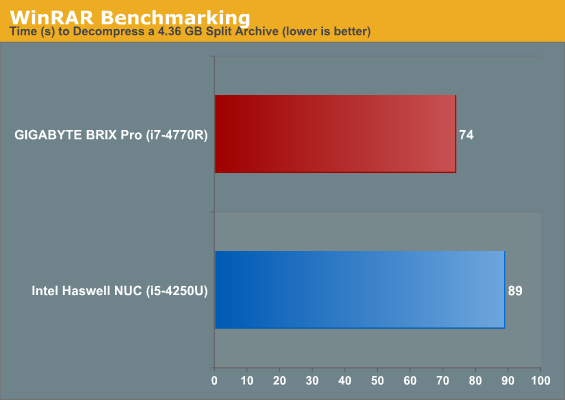
The graph below presents the internal WinRAR benchmark numbers. In this benchmark, the program takes compresses / decompresses random data in the RAM. This is a test of the CPU power as well as the DRAM capabilities.
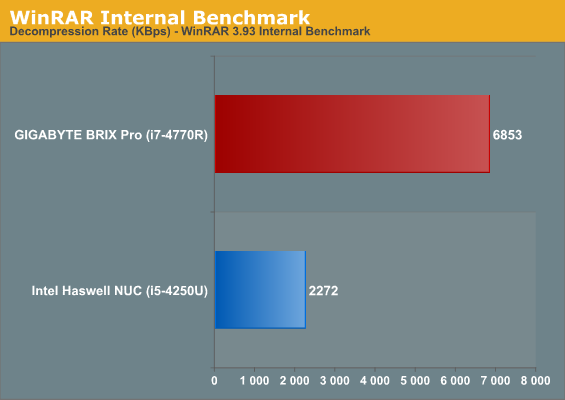
TrueCrypt Benchmark
As businesses (and even home consumers) become more security conscious, the importance of encryption can't be overstated. CPUs supporting the AES-NI instruction for accelerating the encryption and decryption processes have, till now, been the higher end SKUs. However, with Bay Trail, even the lowly Atom series has gained support for AES-NI. Both the i5-4250U and the i7-4770R have AES-NI instructions support. The TrueCrypt internal benchmark provides some interesting cryptography-related numbers to ponder. In the graph below, we can get an idea of how fast a TrueCrypt volume would behave in the two different systems.
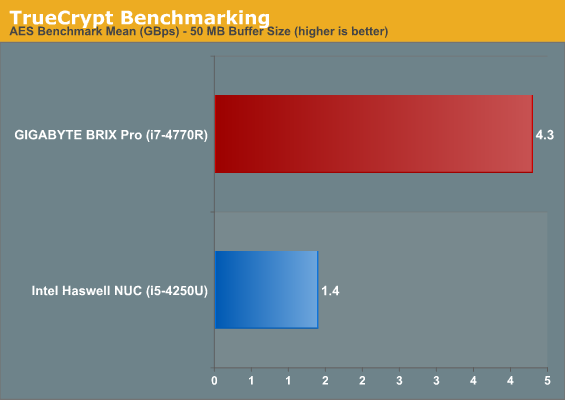
Agisoft PhotoScan
Agisoft PhotoScan is a commercial program that converts 2D images into 3D point maps, meshes and textures. The program designers sent us a command line version in order to evaluate the efficiency of various systems that go under our review scanner. The command line version has two benchmark modes, one using the CPU and the other using both the CPU and GPU (via OpenCL). The benchmark takes around 50 photographs and does four stages of computation:
Stage 1: Align Photographs
Stage 2: Build Point Cloud (capable of OpenCL acceleration)
Stage 3: Build Mesh
Stage 4: Build Textures
We record the time taken for each stage. Since various elements of the software are single threaded, others multithreaded, and some use GPUs, it is interesting to record the effects of CPU generations, speeds, number of cores, DRAM parameters and the GPU using this software.
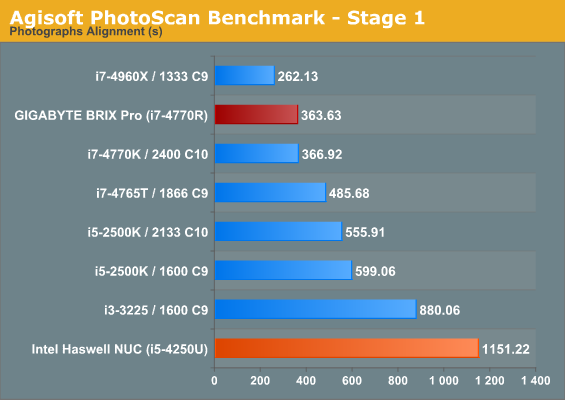
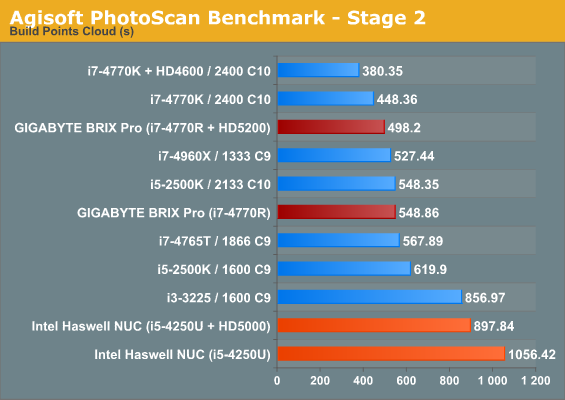

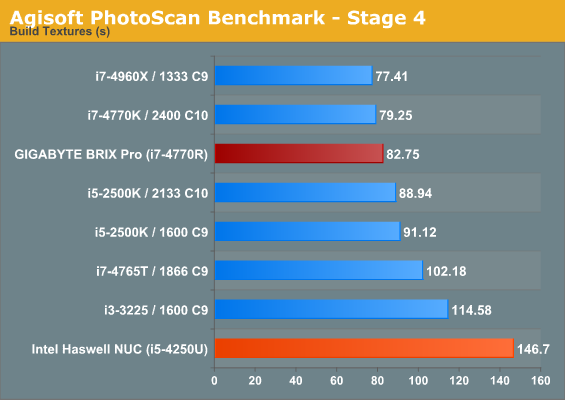
The second stage also reports the throughput rate of the CPU and GPU in million points per second. For the BRIX Pro, in the CPU only mode, we had a rate of 124.99 mp/s. Using OpenCL acceleration, the CPU and GPU had rates of 69.5 mp/s and 98.32 mp/s respectively. The corresponding numbers for the NUC were 68.36 mp/s, 20.39 mp/s and 78.59 mp/s.
Essentially a prosumer real-world test, we hope to put more of our systems under this benchmark in the future. Ian already has a large number of custom-built systems for which he will present benchmarks in his motherboard reviews.










98 Comments
View All Comments
ryrynz - Wednesday, January 22, 2014 - link
Will the Brix be able to run beyond 1600Mhz RAM speeds?ryrynz - Wednesday, January 22, 2014 - link
Seen on Gigabtyes website the G.skill F3-1866C10D-8GRSL is supported to run at 1866Mhz hope you guys manage to chuck something that speed or 2133Mhz in for testing.dwade123 - Thursday, January 23, 2014 - link
Yeah... I rather get a PS4 for less the price.ryrynz - Monday, January 27, 2014 - link
Please test the AMD based GB-BXA8G-8890 as well.luukp - Tuesday, January 28, 2014 - link
What I'm interested in is the difference in performance and noise between the 4570r and the 4770r. I notice that they have the same TDP, but the 4570R has lower clock speed, less features (no hyperthreading) and a higher maximum operating temperature. Based on that, in my mind the 4570r should be able to run much quieter and also be much less likely to throttle. Does that make sense, or am I missing something?ibex333 - Tuesday, January 28, 2014 - link
ummm... lol? For this much money I can build a computer that is only slightly larger and heavier but which will completely obliterate these boxes in gaming performance. Do you want to pay several hundred more just for smaller size and less weight or do you want to have MUCH more performance instead? Is that even a hard decision?DriesV - Wednesday, January 29, 2014 - link
I'm interested in CPU performance only.I need another quad core render node, but my office is cluttered as it is. I don't like to put systems on the floor and I don't have a spare 'server room'.
Then the Brix Pro is an extremely compelling solution. I'd happily pay (I already did actually...) for the much smaller desk real estate required.
DriesV - Wednesday, January 29, 2014 - link
There's always a market for everything. :-)Andresen - Friday, January 31, 2014 - link
"In the second part towards the end of the month...."I'm holding my breath now!
ryrynz - Tuesday, February 4, 2014 - link
And.. you're dead.